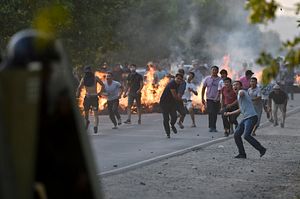BISHKEK — News of a failed raid on Kyrgyzstan’s former president Almazbek Atambayev’s compound in a village south of Bishkek hit local news late at night on August 7. Many in the country were already asleep by then, meaning it was not until the next morning that most heard the news that fighting between special forces and Atambayev’s supporters left 80 injured and 1 man killed.
In Bishkek, the morning of August 8 was quiet; while high-level politicians figured out what message to project, people meandered the streets of Bishkek and children played in the fountains at Ala Too square without an observable sense of urgency. Although nothing much was happening, social media was abuzz.
One of Kyrgyzstan’s most popular social media accounts, One Million Kyrgyz Stories (@omks_kg), posted an image with just one line of text: #МыПротивТретьейРеволюции (in Russian, “We’re Against a Third Revolution”). In the post’s caption, @omks_kg implored locals to avoid getting involved in any demonstrations and to ask their relatives to follow suit.
“None of the four (Otunbayeva doesn’t count) presidents did anything for the people, they didn’t take care of or even think about us. Well, let them squabble among themselves, forget about them,” @omks_kg wrote. “Do not take sides.”
By 6 p.m. on August 8, the original post had 37,000 likes and the hashtag had been tagged in several thousand posts. Several themes emerged in posts from non-news outlets, primarily the need to remain calm, to avoid provocateurs and demonstrations, and the moral bankruptcy of Kyrgyzstan’s political class.
With nearly 1 million followers across Instagram and VKontakte, @omks_kg outstripsthe reach of Kyrgyzstan’s media outlets. While @omks_kg usually posts submissions from followers about everyday life in Kyrgyzstan, on August 8 their Instagram page functioned more like a news hub, with the page administrator gathering updates, photos, and videos from several local Telegram channels and media outlets.
Even though this was not @omks_kg’s normal content, followers were highly engaged, leaving hundreds of comments and watching videos of Atambayev’s eventual capture and police marching through downtown Bishkek more than 10,000 times.
Non-traditional sources of news like @omks_kg, Telegram channels such as Bishkek Sevodnya (Bishkek Today), and forwarded WhatsApp messages competed with accredited media outlets all day. Information poured through multiple digital channels, and it was not always easy to discern what was accurate.
Bishkek elite turned to Twitter to warn people against spreading disinformation. Blogger Marina Kim tweeted in the afternoon of August 8, “Like never before, it’s clear that media literacy, or rather the lack thereof, is a real pain for society. Before writing your ‘They’re saying that 100 thousand Chinese people passed in the direction of Koi-Tash,’ take a deep breath and deny your hands access to the keyboard.”
A major concern is that social media posts containing incorrect information contribute to a tension-conflict feedback loop we might think of as “the provocateur trap.” When Social Democratic Party (SDPK) member and Atambayev ally Adil Turdukulov posted a warning on Facebook that a thousand people were marching from Koi-Tash to Bishkek (the messaged had been deleted by the morning of August 9), some were concerned that this would scare locals into grabbing weapons and engaging in fighting when they wouldn’t have otherwise felt insecure.
But even well-intentioned and thoroughly fact-checked posts contributed to fear and the “provocateur trap.” In an attempt to calm those who couldn’t figure out what to make of the sounds of gunshots and explosions from the city center, city employee and PR specialist Gulya Almambetova tweeted at 10:39 p.m. on August 8, “The situation in the city is under the control of law enforcement! Please refrain from spreading tears and anxieties!”
“Accuracy” can be a nebulous objective, especially when the orientation of major players is unclear and the situation is changing as quickly as it has in Kyrgyzstan over the past few days.
Terms meant to describe the different factions involved in fighting have helped make the series of events more legible to outsiders; the fighting was framed as Atambayev’s supporters versus Jeenbekov’s state security forces. Major media outlets tended to describe masses of people as following a particular politicians; while average people posting on social media referenced individual politicians, usually by a 3-letter acronym, they stuck to less personalistic descriptions of those involved in demonstrations. There were many accusations of “looters” and “provocateurs” in comments on videos of fighting in Ala Too; what these terms lack in analytic leverage (who versus who, for what reason), they more accurately describe the ambiguity in motivation and allegiance among the crowds.
Moreover, information in an article or tweet can be correct but blur geographic boundaries to exaggerate the extent of chaos. With one dose of links, a person reading about the botched attempt to arrest former president Almazbek Atambayev, could think the whole country had gone up in flames. Another person scrolling through Kyrgyz-language social media on August 8 might have had no idea anything was amiss in the capital. Both, in a sense, are “accurate” descriptions of the day, up until nightfall when police fought with a crowd of about 500 men for control of Ala Too square.
The political unrest of the past two days in Kyrgyzstan is not only a wake-up call about the way analysts discuss Central Asia’s “island of democracy,” but also serves as an important lesson on how the corner of the internet you occupy shapes your perception of events.
































